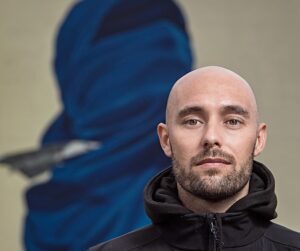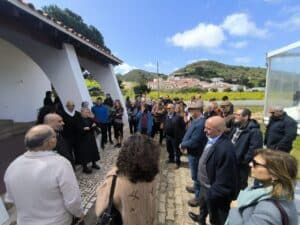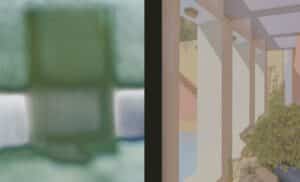Ernesto Mies lives in Seville but frequently travels to the Algarve’s Ria Formosa where he creates stunning paintings of the sandbar islands. Dotted with colourful fishing shacks and boats, his large, bold images are on display at Galeria Côrte-Real in Paderne.
Much closer to Seville, Spain’s Costa de la Luz has no similar coastal formations for the artist to visit. Protected from Atlantic waves by a line of natural sand-made islands, the Ria Formosa’s shimmering lagoon is a tranquil hideaway that appeals to Ernesto’s desire for calm.
The islands shrink and grow as the tide moves in and out; three of them are inhabited – ‘Ilhas’ de Tavira, Armona and Culatra. Notably on Culatra there are small communities of fishermen living with their families and on Armona a cluster of ad-hoc holiday homes.
Other much smaller islands are occupied by a few wooden shacks. Romantically infatuated by the idea of such solitude these places are often the subject of Ernesto’s paintings.
The owners of Galeria Côrte-Real recognise the attraction and have chosen a collection of Ernesto’s most vibrant paintings, as Pedro Côrte-Real explains: “The ramshackle huts that he features are not permanent dwellings but make an ideal base for storing fishing tackle and collecting large quantities of small edible clams, ‘conquilhas’.”
These shellfish (species – Donax) can be seen where the waves wash the sand around. As the tidal levels change, the clams use the action to move themselves up and down the beach, quickly burrowing into a new place before they are swept away. This is the so-called ‘dance of the conquilhas’.
Most easily found at low tide, the fisher-folk arrive by boat onto the sandy islands in search of the sweet shellfish morsels. Equipped with buckets and shovels, they head for the shoreline scanning the sand for air holes and tell-tale signs of tiny bubbles.
The shiny twinkle of a shell or a small hard surface beneath bare feet gives the position of the ‘conquilha’ away. Kept fresh in a bucket of seawater which also helps to remove any grains of sand, within hours they reach restaurants and fish market stalls in Olhão.
One of the Algarve’s most popular delicacies they are usually cooked in their shells, lightly sizzling in olive oil with garlic and coriander.
For more than 12,000 years a continuous supply of ‘conquilhas’ have sustained the inhabitants of the Algarve. In the earliest years primitive tools made of stone or bone probably assisted human efforts but basically the methods have not changed. The simplicity of it suits Ernesto.
“Nowadays I yearn to get away from sophistication and complication,” he says. “This is reflected in my paintings producing compositions that are clean and linear.” Classically trained, his career has spanned four decades and throughout that time his style has undergone several transitions.
Many art collectors in the Algarve have fallen in love with his most recent work. For visitors to the Algarve the paintings are sometimes an introduction to the islands of the Ria Formosa but anyone who has been there can immediately see that Ernesto has captured their bright hues and unspoiled atmosphere.
Galeria Côrte-Real is signposted from Boliqueime, Ferreiras and Paderne. Open Thursday to Sunday, 11am until 5pm.
912 737 762 | www.corterealarte.com
By Carolyn Kain























